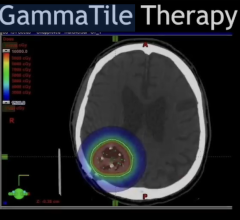May 23, 2012 — Delivering radiotherapy directly to cancer of the cervix using 3-D imaging techniques is effective at controlling the return and spread of the disease and, in most cases, avoids the need for hysterectomies, according to research presented at the World Congress of Brachytherapy last week.
Renaud Mazeron, M.D., said that a review of the use of 3-D image-guided adaptive brachytherapy (IGABT) after a course of chemotherapy and radiotherapy given together (concomitant chemoradiation) in 163 patients treated between 2004-2009 at the Institut Gustave Roussy in Villejuif, France, had shown that it achieved results that were far superior to those from previous eras using different treatments. Not only was IGABT effective at controlling the tumor, but it also had more acceptable side-effects.
At present, there is no conclusive evidence as to whether or not women with cervical cancer, especially if it is at an advanced stage (stage IB-IIB), should have their wombs removed to help to avoid the cancer returning or spreading. This study suggests that hysterectomies may be unnecessary for most women, unless the cancer has obviously returned and invaded the womb.
Mazeron, who is an assistant professor in the radiation oncology department of the Institut Gustave Roussy, said: “IGABT is a three-dimensional technique of brachytherapy allowing a much better adaptation of treatment to the target area, while preserving healthy organs at risk from radiation. Our department has been one of the pioneers of this technique and we already have accumulated significant experience. Our current study does not formally show that surgery is unnecessary, since we did not conduct a randomised comparison, but it shows that IGABT combined with chemoradiation achieves results far superior to the historical data, with high rates of control at the site of the primary tumor.
“In our institute, surgeons have been convinced to abandon systematic surgery by the advances in concomitant chemoradiation and IGABT, and the conjunction of both," he continued. "Historical data based on classical techniques, which gave external radiation without chemotherapy and X ray-based brachytherapy which did not allow to adapt the treatment to each case, show that local control of a stage I tumor was usually around 90 percent, between 60 to 87 percent for stage II, 44 to 66 percent for stage III and 18-48 percent for stage IVA. In this study, we report a rate of 92 percent in a large group of patients with tumors at any stage.”
Of the 163 patients in the study, 27 percent had stage I cervical cancer, 57 percent stage II, 12 percent stage III, and 3 percent stage IV. They received concomitant chemoradiation, followed by brachytherapy that was guided to the correct spot by either magnetic resonance imaging (MRI) in 88 percent of cases, or computerised tomography (CT) in 12 percent of cases.
Sixty-one (37 percent) of the women underwent a radical hysterectomy, but residual cancer cells were found in only 13 of these cases. Mazeron said that the operations were partly because the study covered a pivotal period when surgeons ceased to operate routinely on cervical cancer patients. “At present, surgery is proposed in case of obvious residual tumor after chemoradiation and IGABT. It is sometimes difficult to define complete remission, and thus some patients in the study were operated due to clinical or imaging suspicion of residual tumor, but finally were found to be in complete pathological remission. Currently, surgeons at our institute practice radical hysterectomy following chemoradiotherapy and IGABT only a few times per year, after a biopsy has confirmed that part of the tumor remains. However, in another study, we have shown a worse prognosis, despite surgery, for patients who do not respond completely to radiotherapy or brachytherapy due to a higher risk of metastases,” he said.
After an average followup of 36 months, 45 patients had relapsed, including one woman who had had a hysterectomy, and of whom 70.4 percent had distant metastases. “This clearly shows that distant metastases are the primary cause of relapse,” said Mazeron.
After three years, overall survival and disease-free survival were 84 percent and 73 percent respectively. Control of the tumor at its primary site (local control) decreased in relation to the initial width of the tumour: 97 percent for less than 5 cms, 91 percent for 5-6 cms and 81 percent for 6 cms or more. Only 7.4 percent of patients experienced more severe side-effects (grade 3/4), but of these 12 patients, nine had undergone a hysterectomy after radiotherapy.
“This represents a strong argument for not performing surgery in patients in complete remission after treatment with concomitant chemoradiation and IGABT,” said Mazeron.
He said that IGABT was an emerging technology and the results from this study should be confirmed by two international studies, one of which will be presented at the parallel ESTRO 31 conference in Barcelona [1].
“IGABT is the future of brachytherapy in cervical cancer. Potential financial investments should not discourage radiation oncologists. It costs less than intensity-modulated radiation therapy, a technique of external beam radiotherapy that has become a standard in the treatment of some cancers. We must keep in mind that cervical cancer is a public health problem in developing countries where it is the second most common cancer in women following breast cancer. IGABT represents a significant improvement in results, and some centers are already practicing this technique in India and Southeast Asia,” he concluded.
Christine Haie-Meder, M.D., radiation oncologist at the Institut Gustave Roussy and chairperson of the World Congress of Brachytherapy, commented, “Image-guided adaptive brachytherapy has recently been implemented in cervix cancer patients. Results are in favor of a significant improvement in local control. The present series also contributes to show improvement in local control with IGABT. Within this context, complementary surgery does not bring any further contribution to local control improvement, and hysterectomy may even increase the risk of complications.”
[1] The two studies are: Retro-EMBRACE, a retrospective database comprising data from 600 patients whose first results were presented in Barcelona at ESTRO 31. (Abstract no: PD 213; “Poster Discussion 5: miscellaneous”, 09.00 hrs (CEST)), Friday 11 May, poster area), and EMBRACE, a prospective and large international study that aims at recording data on more than 1,000 patients.


 May 06, 2024
May 06, 2024 








